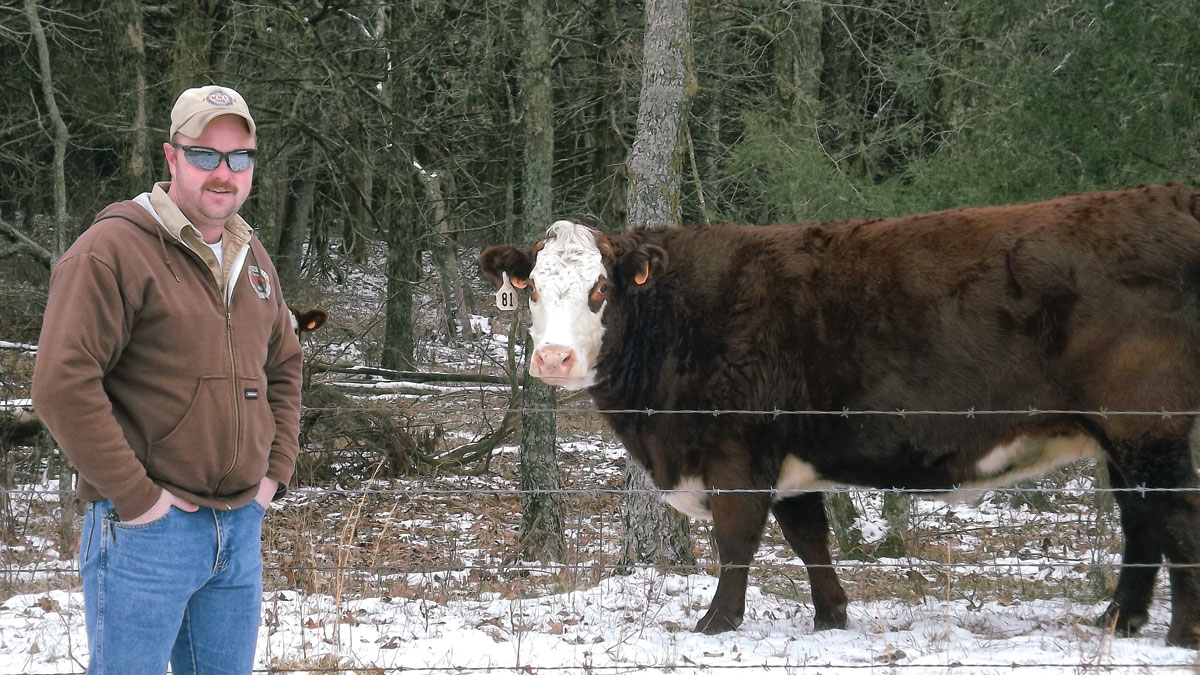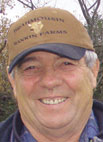
John Love is a thinker, and he’s always thinking of things to improve his family’s farm in St. Clair County, Mo.
The Love Ranch outside of Osceola, Mo., is home to about 50 cow/calf pairs of Angus/Hereford crosses, which graze about 110 rented and owned acres. John said his father, Warren Love, who is also a member of the Missouri House of Representatives, can trace the background of many cows in the herd back 30 years or more, so the roots of the operation run deep. Since Warren spends a great deal of time in Jefferson City, Mo., a larger portion of management of the operation has fallen to John.
John, who is an U.S. Army veteran, attended Columbia College in Columbia, Mo., and received a degree in environmental science. He is open to new ideas on the farm, but said there is always room for practices from the past.
“Probably the best class I took was a soils class,” he said. “You always hear that when you raise cattle, you have to feed the rumen. After taking that class, I realized that we needed to feed the soil first. You have to feed the microorganisms in the soil, just like you have to feed the rumen of a cow because they have to break it down. That’s how I got into trying to build the soil up, rather than just try to take from it.”
Among the ideas he has begun investigating is the incorporation of cover crops in pastures.
“Back in 2012, when the drought hit, we had to buy hay, just like everyone else,” he said. “People just had to pretty much open their gates and the cattle had what they had. That’s kind of when I started looking at doing things a little different.”
John said he began exploring the establishment of other grasses and cover crops.
“I planted oats in the spring of 2012, and then I planted pearl millet,” he recalled. “We almost got out of that year without buying any hay. In the middle of August in 2012, it was the only green field in the entire county. I feel like if we were to go back to scratch and say, ‘We want to raise cows, so what kind of grass do I need to grow?’ I don’t think fescue would be the only grass you would grow.
“I know fescue is a great spring and fall forage, but not so much in the summer because it burns up, but then people will say that when you cut it, you have hay for the winter time. I agree with that, but I just feel like we would be more ahead if we had a little more. When things burn up in the summer, what are they feeding? I think cover crops will really help extend your grazing season.”
John recently took about a 25-acre field with some established gamagrass and broadcasted more gamagrass. Because of the seed cost, John said he only spread about a pound to the acre, which he admitted was light, but since the grass is spreading on its own, he felt a little seed might help spread it a little more.
“I know it is a pain to bale, but I’m trying to get away from baling hay,” he said. “I’m hoping that will turn into our summer pasture.”
John said they use little commercial fertilizer, but they have established a liming regiment.
The Loves also utilize Warren’s aging Allis Chalmers rotobaler. John said while parts are getting a little harder to find, the small bales work well in their grazing system.
“We just leave them in the field,” John explained. “When I was a kid, we never hauled them. I understand that rotational grazing is a new and exciting phrase, and I agree with that, but those little bales have a place.”
John explained that when they hay their fields, every other windrow is baled with the rotobaler. The remaining rows are baled into larger round bales, then hauled out of the field and stored for later use.
In the fall and winter months, the cattle are allowed to strip graze in the field with the bales. John said waste is minimal, and the distribution of manure in the field by having the bales scattered in the area helps increase soil nutrients.
“We don’t have any problems with regrowth. Dad has always said, and I agree with him, that he’d rather take a little longer in the summer than feed hay everyday in the winter,” he said. “We might be feeding hay once a week because we just move an electric fence. I think this year we will be able to graze 365 days on grass and the bales. I do put out big bales, but when they start eating on it more, then I know it’s time to move the fence. If it is going to be real cold, I might unroll one so that they can lay in it.”
He added that Missouri’s winters typically don’t produce enough snow to completely cover the rotobales, so the cattle always have access.
They seldom see the need to run a harrow over the grazed pastures. Fields are also given rest periods from haying and are not cut short.
“I understand the process of photosynthesis and you can’t grow grass if you don’t have leaves,” he said.
In the last couple of years, John has began mob grazing – grazing a large number of animals in a small area for a short time and allowing for longer rest periods in some pastures.
“I don’t have scientific proof, but looking at field that I mob grazed last year, come spring, you could tell a difference,” John said. “Just the undergrowth was great.”
Cattle are also given free choice of 12 loose minerals, including sulfur, iodine, potassium, phosphorus, calcium, magnesium, sodium bicarbonate and Bentonite, which John feels also adds nutrients to the soil through manure deposits.
All things considered, the system is working out pretty well for the Loves.
“Since 2010, we probably have 10 more pairs on about 30 acres less pasture, I think that is a win-win,” John said, adding that he is also seeing new varieties of grasses in the fields.
“If you don’t bale fescue until late June, it smothers all of the other grasses out, so you are stuck. While I have been rotating, we do start off with fescue, but we have other things coming up. I am seeing different grasses that I didn’t even know were in that field because I am giving it a chance.”







